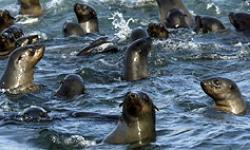Great White Shark Diving, Kleinbaai, Gansbaai, Western Cape, Overberg, South Africa
We dive out at Dyer Island which is situated off the coast from Kleinbaai (Gansbaai). Between the months of May through October is considered to be the best time to view the Great White Shark, although they are seen throughout the year!This is due to the 30 000 strong Cape Fur Seal colony that inhabit Dyer Island, which is the Great White predators primary source of nutrition. The Great White Shark is a surface feeder and thus all the activity takes place on or very close to the surface, due to this, the surface viewing from the boat is excellent.
Once the sharks are around, a specially designed, four-man shark cage, that floats right bellow the surface, is lowered into the clear aquamarine waters. Divers with at least snorkel or regulator experience, may enter the cage where they hold on to its inside ring still out of the water, waiting for the shark to approach closer. This part of the cage is still out of the water /40cm/. Only on the dive master 's command they descend. Divers are never more than 1 meter below the surface.
Divers comfortably step into the cage from the side of the boat. Once in the diving cage, they breath through the "hooker system" /air supplied from the surface on the extended hose, instead of BCD and cylinders on the back/, or just taking and holding their breath. According to our experience this is a well-suited method, providing the safest and most comfortable dive.
Shark Cage Diving: the best time of the year to cage dive with white sharks is from April to September. Four to five sharks are usually encountered in a day with as many as 18 sharks having been encountered on some outings. We have a 95% success rate in terms of daily sightings during the high season. Great white sharks prefer a diet of game fish and from May to October the latter are in abundance. Great whites are also known to feed on seals and carrion. October to December, being the pupping season for some 35,000 seals on Geyser Island, results in an ample food supply of drowned pups in the surrounding coastal waters. Although great whites may be sighted during the low season, the abundance of food in the area makes luring to the boat more difficult.
The water temperature ranges between 55° and 65° F and divers take turns in the cage, each staying approximately 15-20 minutes. A diver can expect to make two to three dives per day if good weather, sea conditions, shark activity and visibility prevails. Visibility is between 4m to 6m on average, but may exceed 15m on a clear day. Sharks may brush the cage, but to date an attack on the cage has not been reported. Great White Shark Diving operators are well worth a visit on your Western Cape Overberg Region Tour or on route to the Garden Route.



The White Shark Diving Company reviews
Login to comment